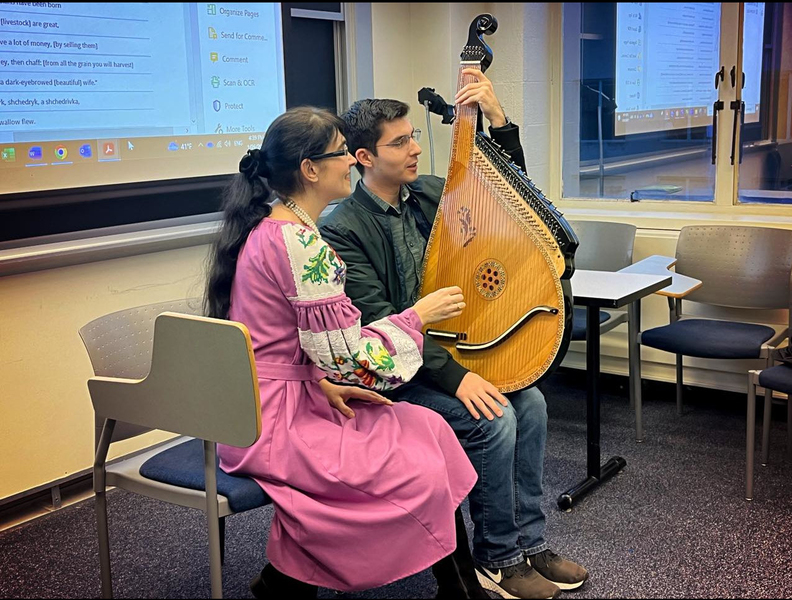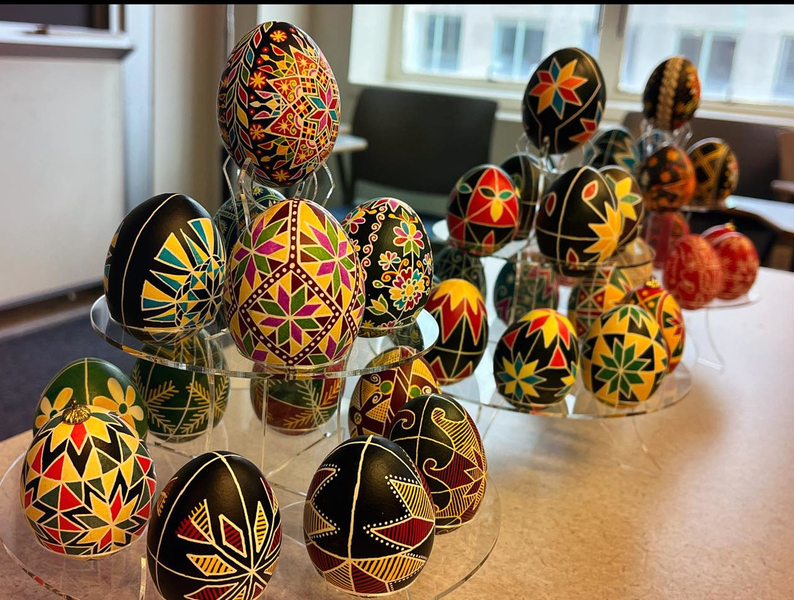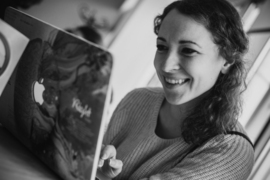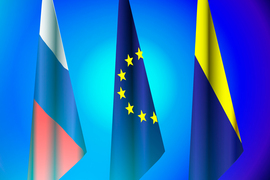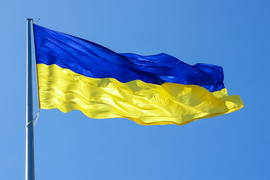In a new course that ran this Independent Activities Period (IAP), MIT students studied Ukrainian language and culture and heard from Ukrainian scholars, artists, and activists about the country and the ongoing struggle against the devastating Russian invasion.
As Russia began its full-scale invasion of Ukraine in February 2022, Maria Khotimsky, senior lecturer in Russian in MIT Global Languages, recalls seeing tremendous student and faculty action around MIT. Khotimsky got to know MIT’s Ukrainian students through rallies, events, and volunteer efforts they organized. Simultaneously, she says, there was a strong push to jump-start MISTI 's MIT-Ukraine program.
“My biggest inspiration was the Ukrainian students I’ve met,” says Khotimsky. “Talking with the students, they asked why we don’t have Ukrainian [courses], and my immediate response was that we would love to offer something.”
Khotimsky worked with Elizabeth Wood, MIT professor of history, to guide the course from concept to reality, culminating with its inaugural run over the last few weeks. The course catalog planning process is a painstaking one; it can take between one and two years to get a new course running during the semester. Instead, Wood and Khotimsky aimed for IAP — a period when it is easier to get a pilot course running.
One of the many reasons why it’s important to bring this course to MIT, says Khotimsky, is “obviously, is to show support and solidarity to the Ukrainian community here at MIT and to offer our students an opportunity to learn, as well as to support the emerging efforts of MISTI Ukraine and other collaborations across many departments in support of Ukrainian scholars and war relief.”
Spearheading this new course is Iryna Kovalchuk, a Slavic linguist and cultural instructor who was born in eastern Ukraine and now teaches at Harvard University. Kovalchuk was invited by MIT Global Languages to teach this course specifically, both because of her language scholarship and because of her deep ties to artist communities after working for years as a cultural events manager. From both fields of expertise, Kovalchuk designed the course.
“My goal was, first, to show the most interesting parts of Ukrainian culture and history,” she reflects, “and, second, the facts that are important now to understand the war, the causes of the war, and to uncover — maybe small things — but which are crucial for students’ better comprehension.”
Unlike other IAP language courses, which are generally compressed to offer an intensive language introduction and allow students to transition into the spring semester, Khotimsky and Kovalchuk envisioned this course differently. Instead of a language crash course, this new class would focus both on Ukrainian language and culture. Students engage with the customary introductory language tools but are also introduced to members of the Ukrainian community around MIT, Boston, and the New England area, giving students the tools to continue to engage with and support the Ukrainian people into the future.
“When I started thinking about the language part of the syllabus,” Kovalchuk said, “I thought that students will need to know how to react to the most common communicative situations, form simple statements in writing, and they need to know how to read in Cyrillic (understanding the main idea of the text and necessary details). Mostly, I wanted to give them some useful tools to use in the future when the course is over.”
Students took the MBTA Red Line twice: to take part in a conversation with Ambassador (ret.) Marie Yovanovitch (who served as U.S. ambassador to Ukraine in 2016-19) and to to visit Harvard’s Ukrainian Research Institute, where they learned about resources to study Ukraine, opportunities to take part in conferences, seminars, and talks about the war as well as where to search for literature, and archival materials from the Widener Library collections. Artist Alona Popova, a representative of the Ukrainian Cultural Center of New England, visited the class to teach about pysanky, the Ukrainian art of painting layered, intricate designs on the delicate surface of eggs. Popova also taught the students vytynanka, the equally delicate Ukrainian art of cutting paper to create beautiful designs.
“I knew from the beginning that I didn’t want this course to be about war or wars and struggle only — even during the war,” Kovalchuk reflects. “I wanted this class to be about life, about Ukrainians’ will to be free on their land, with their language and their huge creative potential."
Students spoke with social linguist Nadiya Kiss, who walked them through analyses of language activism in Ukraine as language ideology. Scholar Joanna Fomina spoke to the class from Warsaw on the situation of Ukrainian refugees in Poland as well as outlining public, political, and policy responses. During one of the final classes, Olena Tsar, singer and bandura player, demonstrated how to play the traditional Ukrainian instrument and even walked students through playing “Shchedryk” — a traditional Ukrainian New Year's song that was composed by Ukrainian composer and teacher Mykola Leontovych and was later adapted to the English “Carol of the Bells.” On the last day of classes, students enjoyed a Ukrainian dance workshop taught by Anita Dey Barsukova, leader of MIT Ukrainian Folk Dance Ensemble and current graduate student at the Department of Mechanical Engineering.
In one powerful and moving visit, MIT sophomore Sasha Horokh described their work on Mriya, a student-run nonprofit in Boston that has delivered more than $50,000 of humanitarian and medical aid supplies to Ukraine via fundraising in 2022. Horokh spent last summer and most of IAP 2023 in their native Ukraine, delivering supplies and rescuing pets. They gave a harrowing vision of the war’s front lines and their family, friends, and teachers who are fighting there.
From the first day of class, Kovalchuk was impressed with the classroom energy, and the eagerness of the students to engage with and embrace new material. “I was amazed from the beginning how much desire for knowledge I could see in the students’ eyes. I understand that these students are among the best in the world, but they are still humble and this helps them to get more from classes.”
Khalid Ajran, an MIT sophomore studying math and computer science who’s originally from Saudi Arabia, was delighted to discover the similarities between Ukrainian and his native Arabic. Ajran was drawn to the class by his love of language learning, though he “didn’t have any deep background relating to Ukraine,” but discovered both linguistic and technological bridges, tying into his broader studies in computer science.
In the class’s final meeting, one student commented that their experience in the course had given Ukraine a “face”: a sense of the people, humanity, and culture behind the headlines. And, as Kovalchuk notes, it’s easier to connect and lend aid with that contextual knowledge and concrete sense of place.
The IAP students are organizing a fundraising drive — featuring socks they taught themselves how to sew in order to decorate with Ukrainian flags — timed around the Feb. 24 anniversary of the Russian invasion. Using the tools from this course, they now have connections to local Ukrainian aid groups and communities, as well as the MIT-Ukraine program.
“MIT has already launched several programs/initiatives to cooperate with Ukrainian researchers, to support Ukrainians,” says Kovalchuk. “I think even the smallest language and cultural background is needed in order to communicate properly with partners from Ukraine and in future — to visit Ukraine, or further, to take part in the process of rebuilding it.”
